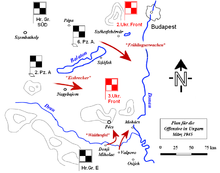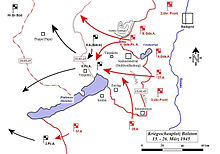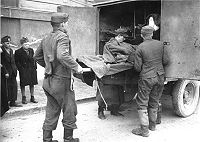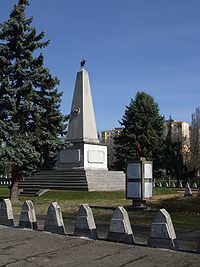- Operation Frühlingserwachen
-
Operation Spring Awakening Part of World War II, Eastern Front 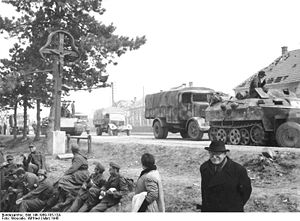
German units during the Lake Balaton Offensive, March 1945.Date 6-16 March 1945 Location Lake Balaton, Hungary Result Soviet and Bulgarian victory Belligerents  Germany
Germany
 Hungary
Hungary Soviet Union
Soviet Union
 Bulgaria
BulgariaCommanders and leaders  Josef Dietrich
Josef Dietrich
(6th SS Panzer Army) Fyodor Tolbukhin
Fyodor Tolbukhin
(3rd Ukrainian Front)Strength 140,000 men
900 AFVs465,050 men
168 tanks
437 SP gunsCasualties and losses German source:
12,358 dead, wounded
and missing
31 tanks[1]
Russian Claim:
40,000 casualties,
more than 300 cannons,
500 tanks,
more than 200 aircraft[2]8,492 killed and missing
24,407 wounded and sick[3]Naval warfare
- Baltic Sea
- Black Sea
- Arctic
1941
1942
- Battles of Rzhev
- Toropets and Kholm
- Demyansk
- Velikiye Luki
- Mars
- 2nd Kharkov
- Case Blue
- Stalingrad
1943
1944
- Dnieper and Carpathian
- Leningrad and Novgorod
- Narva
- Hube's Pocket
- Crimea
- Jassy-Kishinev
- Karelia
- Bagration
- Lvov and Sandomierz
- 2nd Jassy-Kishinev
- Baltics
- Debrecen
- Petsamo and Kirkenes
- Hungary
1945
Operation Frühlingserwachen ("Spring Awakening") (6-16 March 1945) was the last major German offensive launched during World War II. The offensive was launched in Hungary on the Eastern Front. This offensive was also known in German as the Plattensee Offensive, in Russian as the Balaton Defensive Operation (6-15 March 1945), and in English as the Lake Balaton Offensive.
The offensive was launched by the Germans in great secrecy on 6 March 1945. The German attacks were centered in the Lake Balaton area. This area included some of the last oil reserves still available to the Germans.
Operation Spring Awakening involved many German units withdrawn from the failed Ardennes Offensive on the Western Front including the 6th SS Panzer Army.
Contents
Order of battle
The Axis forces:
- Elements of the German Army Group South (Heeresgruppe Süd)
- German 6th SS Panzer Army - Included the 1.SS Division "Leibstandarte Adolf Hitler"
- German 2nd Panzer Army
- German 6th Army ("Armeegruppe Balck")
- Hungarian Third Army
- Elements of the German Army Group E (Heeresgruppe E)
The Soviet forces:
- Elements of the Soviet 3rd Ukrainian Front
- 4th Guards Army
- 6th Guards Tank Army
- 9th Guards Army
- 26th Army
- 27th Army
- 46th Army
- 57th Army
- Bulgarian First Army
German plan
The German plan of attack against Soviet General Fyodor Tolbukhin's 3rd Ukrainian Front was ambitious. German General Sepp Dietrich's 6th SS Panzer Army was responsible for the primary thrust of the German attack. The army was to advance from an area north of Lake Balaton on a wide front. They were to push east through the Soviet 27th Army and to the Danube River. After reaching the river, one part of the Army would turn north creating a northern spearhead. The northern spearhead would advance through the Soviet 6th Guards Tank Army and move along the Danube River to retake Budapest. The city had fallen on 13 February 1945. Another part of the 6th SS Panzer Army would then turn south and create a southern spearhead. The southern spearhead would move along the Sio Canal to link up with units from German Army Group E. Army Group E was to thrust through Mohács and, moving north, meet up with the southern spearhead of the 6th SS Panzer Army. If successful, the meeting of the southern spearhead and of Army Group E would encircle both the Soviet 26th Army and the Soviet 57th Army.
The German 6th Army would keep the Soviet 26th Army engaged while it was surrounded. Likewise, the German 2nd Panzer Army would advance from an area south of Lake Balaton towards Kaposvár and keep the Soviet 57th Army engaged. The Hungarian Third Army was to hold the area north of the attack and to the west of Budapest.
German attack
As planned, the offensive got under way on 6 March. It was spearheaded by the German 6th SS Panzer Army. The spearhead included elite units like German dictator Adolf Hitler's personal unit, the Leibstandarte Adolf Hitler Division. Despite the extremely muddy conditions, the Germans managed to attack effectively and take the Soviets by surprise. Impressive gains were made for an offensive launched at such a late date in World War II.
However, once the Soviets realized that elite SS units were involved in the attack, they took the offensive seriously. Gathering large forces to counter the 6th SS Panzer Army's gains, they brought the attack to a standstill.
By 14 March, Operation Spring Awakening was already in serious trouble. At that time, Joseph Goebbels wrote in his diary that failure of the offensive was likely. The advance of the 6th SS Panzer Army, while impressive, was well short of its ambitious goals. The German 2nd Panzer Army did not do so well south of Lake Balaton as the 6th SS Panzer Army did, north of Lake Balaton. Army Group E met fierce resistance from the Bulgarian First Army and Josip Broz Tito's Yugoslavian partisan army, and ultimately failed to reach its objective, Mohács.
Soviet counterattack and subsequent operations
On 16 March, the Soviets counterattacked in strength. Within 24 hours of the Soviet counterattack, the Germans were driven back to the positions they held before Operation Spring Awakening.[4]
On 22 March, hopelessly out-numbered and with few armoured vehicles remaining, the surviving German forces withdrew to prepared positions elsewhere in Hungary. The Soviet counteroffensive continued and these positions were soon over-run.
On 30 March, the Soviet 3rd Ukrainian Front crossed from Hungary into Austria.
By 4 April, Sepp Dietrich's 6th SS Panzer Army were already in the Vienna area desperately setting up the city's defenses against the anticipated Soviet Vienna Offensive. Already approaching and encircling the Austrian capital city were the Soviet 4th Guards Tank Army, the Soviet 6th Guards Tank Army, the Soviet 9th Guards Army, and the Soviet 46th Army.[4]
By 15 April, the remnants of the 6th SS Panzer Army were north of Vienna. They faced the Soviet 9th Guards Tank Army and the Soviet 46th Army. The Soviet's Vienna Offensive had ended. The city fell to the Soviets on 13 April.
By 15 April, the remnants of the German 6th Army were north of Graz. They faced the Soviet 26th Army and the Soviet 27th Army.
By 15 April, the remnant of the German 2nd Panzer Army were south of Graz in the Maribor area. They faced the Soviet 57th Army and the Bulgarian First Army. Between 25 April and 4 May, the 2nd Panzer Army was badly bloodied by both armies near Nagykanizsa during the Nagykanizsa–Kermend Offensive.
Between 16 and 25 April, the Hungarian Third Army was destroyed about 40 km (25 mi) west of Budapest. They were destroyed by the Soviet 46th Army which was driving towards Bratislava and on to the Vienna area.
Some Hungarian units survived the fall of Budapest and the destruction which followed when the Soviets counterattacked after Operation Spring Awakening. The Hungarian Szent László Infantry Division was still indicated to be attached to the German 2nd Panzer Army as late as 30 April.
Aftermath
Almost inevitably, Operation Spring Awakening was a failure for the German Army (Wehrmacht Heer). Despite early gains, the operation was a prime example of Hitler's reckless military judgement towards the end of the war. Its chief flaw was that the offensive was much too ambitious in scope. Not only were the Germans supposed to retake Budapest, but the Nagykanizsa oil fields south of Lake Balaton were to be defended. In addition, Hitler expected this German offensive to push the Soviet 3rd Ukrainian Front back to the Danube River and prevent Soviet General Rodion Malinovsky from continuing his army's advance into Hungary.
Strategically, Operation Spring Awakening had no impact upon the outcome of World War II. On a tactical level, the operation highlighted the fighting qualities of the German army that still existed. But within 24 hours of the Soviet counterattack, the Germans were driven back to the positions they held before the operation.
Armband order
This debacle is famous for the notorious "armband order" which followed. The order was issued to the commander of German 6th SS Panzer Army, Sepp Dietrich, by Adolf Hitler, who claimed that the troops, and, more importantly, the Leibstandarte Adolf Hitler, "did not fight as the situation demanded."[5] As a mark of disgrace, the Leibstandarte units involved in the battle were ordered to remove their treasured "Adolf Hitler" cuff titles (German: Armband). In the field, Sepp Dietrich was disgusted by Hitler's order and did not relay it to his troops.
See also
- Eastern Front (World War II)
- History of Germany during World War II
- Hungary during the Second World War
- Military history of Bulgaria during World War II
- Battle of Budapest - 1944/45
- Battle of Drava - 1945
- Nagykanizsa–Körmend Offensive - 1945
- Vienna Offensive - 1945
- Prague Offensive - 1945
- Soviet 3rd Ukrainian Front
- German 6th SS Panzer Army
- German Leibstandarte Adolf Hitler Division
- Hungarian Third Army
- Bulgarian First Army
References
- ^ Frieser, Karl-Heinz; Klaus Schmider, Klaus Schönherr, Gerhard Schreiber, Kristián Ungváry, Bernd Wegner (2007) (in German). Das Deutsche Reich und der Zweite Weltkrieg - Vol. 8: Die Ostfront 1943/44 - Der Krieg im Osten und an den Nebenfronten. Deutsche Verlags-Anstalt München 2007, ISBN 3421062358, Page 942
- ^ Коллектив авторов. История Второй мировой войны. 1939—1945. Том 10. — М.: Воениздат, 1979
- ^ G.F. Krivosheyev, 'Soviet Casualties and Combat Losses in the twentieth century', London, Greenhill Books, 1997, ISBN 1853672807, Page 110
- ^ a b Page 182, The Decline and Fall of Nazi Germany and Imperial Japan, Hans Dollinger, Library of Congress Catalogue Card Number 67-27047
- ^ Page 198, The Decline and Fall of Nazi Germany and Imperial Japan, Hans Dollinger, Library of Congress Catalogue Card Number 67-27047
World War II Participants Timeline Aspects GeneralWar crimes- German and Wehrmacht war crimes
- The Holocaust
- Italian war crimes
- Japanese war crimes
- Unit 731
- Allied war crimes
- Soviet war crimes
- United States war crimes
- German military brothels
- Camp brothels
- Rape during the occupation of Japan
- Comfort women
- Rape of Nanking
- Rape during the occupation of Germany
- Nazi crimes against Soviet POWs
- Italian prisoners of war in the Soviet Union
- Japanese prisoners of war in the Soviet Union
- Japanese prisoners of war in World War II
- German prisoners of war in the Soviet Union
- Finnish prisoners of war in the Soviet Union
- Polish prisoners of war in the Soviet Union
- Romanian prisoners of war in the Soviet Union
- German prisoners of war in the United States
Categories:- Battles involving the Soviet Union
- Battles involving Hungary
- Battles involving Bulgaria
- Conflicts in 1945
- Military operations of World War II involving Germany
- Battles and operations of the Soviet–German War
- Bulgaria–Soviet Union relations
Wikimedia Foundation. 2010.

